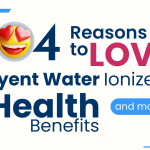Find out how drinking water with arsenic can endanger you and your family.
RELATED: Get The Lead Out: How Is Your State Doing?
In this article:
- What Is Arsenic?
- Where Does Arsenic Come From?
- How Does It Get into Drinking Water?
- When Is Arsenic in Drinking Water Hazardous?
- What Are the Negative Health Effects of Arsenic?
- Who Should I Call to Have My Water Checked?
- How Do I Remove High Levels of Arsenic from My Drinking Water?
- What Arsenic Removal Technologies Are Available?
- Can You Bathe in Water with Arsenic?
- How Do I Get Arsenic Out of the Body?
Everything You Need to Know About Arsenic in Water
What Is Arsenic?
Arsenic (As) is a toxic naturally occurring element found throughout the Earth’s crust and a byproduct of a number of agricultural and industrial processes.
Even at high concentrations, this element is colorless, tasteless, and odorless when dissolved in water. It can only be spotted through laboratory analysis.
Where Does Arsenic Come From?
It is produced in coal burning, mining, and copper smelting. In the agriculture industry, it is combined with other chemicals to preserve wood and kill pests.
How Does It Get into Drinking Water?

This element may naturally enter rivers, lakes, and underground water when arsenic-containing minerals like rocks dissolve and erode.
Pollution is also a culprit for arsenic contamination as a number of industries release high levels of it into the environment every year.
Once discharged, arsenic may stay in the environment for long periods of time. When it reaches the ground or surface water, it can slowly enter groundwater.
Private wells with high arsenic levels may be a result of industrial waste, arsenic-containing fertilizers and pesticides used in the past.
Activities that could leave arsenic residue include:
- apple orchard spraying
- use of some pressure treated wood
- coal ash disposal
When Is Arsenic in Drinking Water Hazardous?
According to the U.S. Environmental Protection Agency (EPA), the current Maximum Acceptable Concentration (MAC) of arsenic in drinking water is 10 μg/L or 0.010 milligrams per liter (mg/L).
This measure is set in consideration of the practical difficulty of making drinking water arsenic-free. Because of this, people are advised to take necessary precautions if their drinking water has arsenic levels even below the given MAC.
What Are the Negative Health Effects of Arsenic?
People may experience arsenicosis or arsenic poisoning from short-term (days to weeks) intake of arsenic-contaminated drinking water.
The symptoms of arsenicosis may include:
- vomiting
- diarrhea
- stomach pain
- impaired nerve function which can manifest in numbness and burning in the limbs or pins and needles sensation
- fatigue due to decreased production of red blood cells
Arsenic ingestion can also lead to skin changes such as:
- skin darkening
- corn-like or wart-like growths on the palms or the soles
- skin flushing
- rashes
Elemental arsenic and its compounds are poisonous and classified as group 1 carcinogens. Long-term (years to decades) ingestion of even relatively low levels of arsenic in drinking water can increase the risk of cancer in the:
- kidney
- lungs
- skin
- liver
- bladder
It is important to note that children are at a higher risk of arsenic poisoning as they tend to drink more water per body weight compared with adults.
Who Should I Call to Have My Water Checked?
If your household is connected to a public water system, you can check with its operator if there is arsenic in your water. Or, get your free water report from Tyent.
If you are, on the other hand, on a private well or an unregulated water system, you can check a list of qualified and certified laboratories from your respective state public health department who can test your drinking water.
How Do I Remove High Levels of Arsenic from My Drinking Water?

If your drinking water tested positive for high levels of arsenic, there are certain treatment methods you can use. Before that, it is important to consider the following factors:
The Kind of Arsenic Present
There are two forms of arsenic usually found in drinking water: Arsenate or Arsenic 5 and Arsenite or Arsenic 3. Knowing which kind of arsenic is present will determine the kind of treatment you can use.
Arsenic 3 is harder to remove as it has to be oxidized into Arsenic 5 first. This happens when oxidizing agents such as liquid chlorine (bleach), ozone, or hydrogen peroxide are added to the water.
Treatment Device Installation
You will have to choose from a point-of-use (at the tap) or a point-of-entry (whole house) treatment device. The former is installed under the kitchen sink and is usually used to produce purified drinking water; the latter is installed in the main water line treating all the water that enters your house. Tyent offers advanced point-of-use filter options, which we will cover in just a bit.
Other Minerals Present in Water
There may be other chemicals in the water such as manganese or iron that has to be removed first before the treatment to ensure its effectivity.
Remember to ask the laboratory what they need to get such results as they may require you to bring extra water samples.
Merely boiling contaminated water will do nothing. In fact, this may increase arsenic concentration.
What Arsenic Removal Technologies Are Available?
Anion Exchange
An anion exchange treatment will remove one or more water contaminants by exchanging them with another substance. In this situation, chloride replaces arsenic.
Anion exchange systems are generally installed to treat water for an entire house. They need very little maintenance.
Anion Definition: A negatively charged ion.
Reverse Osmosis
Reverse osmosis is a point-of-use treatment system that usually requires prior sand and grit filtration to avoid messing up the device. This treatment method cannot remove arsenic 3.
RELATED: Reverse Osmosis Process: How Does It Work?
Activated Alumina
Most absorptive methods including the use of activated alumina.
Adsorption Definition: This is a process where gas, liquid, or dissolved solid molecules cling to a solid like a thin film.
This method’s efficiency depends on the pH of the contaminated water hence, you will have to pre-treat for pH adjustment.
To significantly remove arsenic 3, you will need to install a device with one single adsorptive media cartridge plus a pre-oxidation cartridge ahead of it.
The TYENT 2-Bank Fluoride System employs a 2-stage filtration process that uses 100% activated alumina to remove up to 95% of fluoride and arsenic in the first stage.
The second stage comes with KDF55 that reduces heavy metals like lead, mercury, and nickel; and catalytic carbon that filters out iron, hydrogen sulfide, manganese, and chloramines.
KDF55 Definition: Kinetic Degradation Fluxion is a filtration method that uses high-purity copper-zinc granules to reduce water contaminants using oxidation or reduction reaction. KDF55 is a kind of KDF that reduces heavy metals and chlorine.
Can You Bathe in Water with Arsenic?
Arsenic contaminated water is only dangerous when ingested through drinking or preparing food.
Skin contact or exposure through breathing is not harmful. There are no known negative health effects from using water with arsenic for washing hand, bathing, or washing clothes.
How Do I Get Arsenic Out of the Body?
Eating foods rich in sulfur like onions, garlic, eggs, beans, legumes, and fish may help as sulfur protects cells from the effects of toxins and assists in bile production.
Bowel irrigation may also help. In this procedure, doctors will pass a special solution through the digestive tract to flush out its contents including traces of arsenic.
Chelation therapy is also an option. This method isolates arsenic from blood protein with the use of chemicals like dimercaptosuccinic acid and dimercaprol.
Aside from arsenic, there are other more common contaminants that may affect your family’s health. Have your water tested or simply download your FREE water report and install high-quality water ionizers at home to ensure the safety of your drinking water.
Do you have any other questions about the effects of drinking water with arsenic? Let us know in the comments section below!
Up Next:









